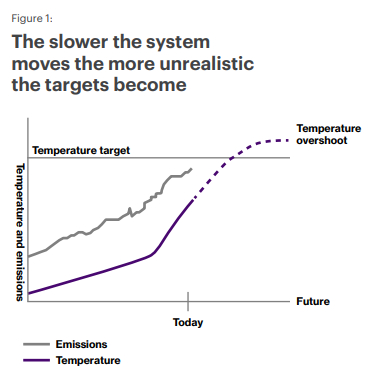Climate disclosures are in danger of ticking boxes while the earth system passes critical thresholds. To achieve climate resilience, organizations need to better understand the risks and realities.
Generic statements, significant underestimates of risk and a lack of detail on plans to meet targets are common characteristics of many climate disclosures currently produced globally, research by the Financial Reporting Council finds. We agree that many disclosure activities are not supporting organizations' ability to address and adapt to physical climate risks or develop management plans to navigate and accelerate the transition.
Organizations need to refocus on assessing climate risks more carefully and setting more realistic management plans. You can only do this by considering the total environmental and economic systems that determine the operating landscape. Only then can you take decisions that create more resilient business models and operations.
In this paper, we consider the shortcomings of current climate activities and suggest practical steps you can take to access decision-useful information in a constantly changing landscape.
Milestones and critical thresholds
Business leaders are concerned with how big picture trends impact operations and profitability. When looking at the factors that define the operating landscape — the physical environment, the make-up of economic activities and social expectations — there is much change ahead.
The continued increase in losses from disaster events means we should think about a new normal, indicated by our Natural Catastrophe Review, which shows not only are total losses higher, but small to mid-size events are now more costly than the large headlinegrabbing events. Why 2023 was the warmest year in possibly the past 100,000 years remains a source of further study and concern. What's clearer is the physical environment is changing fast, faster than we had previously thought, and with more warming to come., which shows not only are total losses higher, but small to mid-size events are now more costly than larger headline-grabbing events.
Why 2023 was the warmest year in possibly the past 100,000 years remains a source of further study and concern.
The transition to a net-zero economy is estimated to require an annual average of $3 trillion in capital investment between now and 2050.
Meanwhile, efforts toward finding and delivering routes to move the economy to a lower carbon state continue. The transition to a net-zero economy is estimated to require an annual average of $3 trillion in capital investment between now and 2050,research published by the Energy Transitions Commission shows. This is inclusive of declines in investment into higher carbon sectors, and with current levels of investment at around $1 trillion a year, this is a trend that will reach all areas of the economy and create a series of winners and losers.
Are climate disclosures achieving their objectives or tick-box exercises?
Attention so far on climate and sustainability has focused on the impact of a business on the world and society. This has more recently expanded to cover the assessment and disclosure of risks and opportunities from climate change to a business. The global rollout of climate and sustainability reporting and the emergence of new ones, such as the Taskforce on Nature-related Financial Disclosures (TNFD), illustrate a trend.
However, concern is growing on whether outcomes from these exercises are meeting their original objectives: to help companies and stakeholders respond to the risks and opportunities from climate change, (this concern highlighted in research by Stanford University). If risk assessment processes are simplistic and not reflective of the real world, they are not decision-useful. A reliance on subjective judgments of materiality, promises and future targets is more focused on internal dynamics rather than helping businesses navigate the changing operating landscape. Of most concern is this is happening at a time when climate scientists are warning the earth system has passed critical thresholds and carbon budgets, which companies are committing to try to avoid.
Disclosure processes offer a useful and important framework to identify and understand the universe of climate risks and opportunities. Collecting and sharing information about a company's activities, and educating internally and externally about changes to the operating landscape, provide a level of confidence in the activities of the reporting entity.
But it is not the same as operational and financial resilience in an era of change.
Your organization needs to be ready to position for a new normal and climate disclosures as they currently stand aren't enough to get you there.
Disclosure processes offer a useful and important framework to identify and understand the universe of climate risks and opportunities.
Opportunities, risk and realities within the entire system
Climate risks and opportunities are about the realities of the entire system. There is a global carbon budget associated with each degree of temperature change. The slower the system moves to a low carbon state, the higher the current level of emissions, and the higher the future temperature change. In other words, the more unrealistic reaching the more ambitious targets, such as 1.5°C, becomes.
The reason for the ambitious targets is to lessen and avoid fundamental changes to the physical environment. These biophysical realities determine the future operating landscape for all businesses.
To understand climate risk and opportunity appropriately, we must look across the entire system — the earth system, the economic system and the social system. Risk and opportunity do not always end up where they might first appear. They can be shared, deferred and manipulated.
Business planning is always done on projections of the future, estimating for uncertainty and assigning probabilities. Climate risk assessment is just one trend to factor into business planning. Just like other risks, projections and modeling must remain rooted in realworld developments. And with climate, it must come back to earth system science.

Source: https://www.worldenergydata.org/remaining-carbom-budget/
Understanding your organization as part of wider systems
Understanding how and when physical risks and transition risks will affect your future profits may not be part of current climate disclosure guidelines but should be part of your routine business management to ensure enduring success. The individual business model and operational structures of your organization, and the structure of the markets it operates in, will determine its financial exposure to these risks. And it's the comprehensiveness and speed of your response today which will influence your exposure and competitive advantage tomorrow.
Companies within industries expected to decline in the transition, for example those in oil extraction or internal combustion engines, will have to manage decreases in demand and volatility in margins. These companies will need to align business strategy and risk management with both the move to a low carbon economy, as well as what's actually happening in the marketplace. For example, if decreases in demand are slower than assumed, then the financial risk may well be lower.
Likewise for a company expected to grow with the energy transition, for example, wind turbines or electric vehicle businesses, there is risk in overestimating upsides or not aligning the timing of investments with the transition. The financial risk depends on the difference in expectations of companies, consumers, investors and governments, and the reality of how the economy transitions to a lower carbon state.
Understanding how and when physical risks and transition risks affect future profits must be part of routine business management.
The journey is not straightforward, so your business remaining flexible will likely prove of lasting value in this process.
While there is some uncertainty in how these changes will play out, it's decreasing over time as technology and policy outline future pathways. Customer preferences, technological progress and policy and regulation are all drivers. Climate policy and industrial policy move ever closer together, changing incentives and decision-making. Economic rationality matters, but real-world pressures will continue to be influential. This makes precision hard.
Understanding how and when physical risks and transition risks will affect future profits must be part of routine business management. This is required to determine business strategy, capture future opportunities and manage risk. The journey is not straightforward, so your business remaining flexible will likely prove of lasting value in this process.
Developing flexible business models against changing physical and transition risks
The direction of travel on the transition to a low carbon economy is clear. The primary question is on the timing and scale of impact along the way. Also clear is the continued increase in disruption and damage, and potential natural and financial tipping points. The business challenge is to develop an operating model with capacity to withstand such pressures.
These trends alter risk and return considerations for companies, investors and governments. Any suitable analysis will allow constant assessment and adjustment. Analysis should also acknowledge uncertainty, look across the system and seek to quantify financial impacts.
If we assess and quantify such changes in a consistent manner, there are routes to benefiting organizations and the whole system — which in turn benefits the organization. And risk assessment in a manner acceptable to financial markets allows capital and risk to be brought closer together.
We recommend organizations refocus climate efforts in two ways: broadening the focus to the wider systems in which your business plans operate, and sharpening your climate risk view to make it useful to delivering financial and operational resilience. In this era of change, an over-reliance on simplistic models that don't reflect the dynamic environment is unwise, while individual, qualitative judgements will continue to fall short.
If we assess and quantify such changes in a consistent manner, there are routes to benefiting organizations and the whole system
To manage the climate challenge effectively, you will need to understand the core drivers of change to remain aligned with financial and risk management best practice and keep a continual focus on real world dynamics.
A refocused climate risk assessment and management approach will work through these principles in terms of risk and return. The effect is to move the system closer to a position that is more resilient and lower carbon, which is surely the end objective for business and for society, alongside the need to satisfy current compliance and stakeholder requirements.
To manage the climate challenge effectively, you will need to understand the core drivers of change to remain aligned with financial and risk management best practice and keep a continual focus on real world dynamics.
The content of this article is intended to provide a general guide to the subject matter. Specialist advice should be sought about your specific circumstances.




